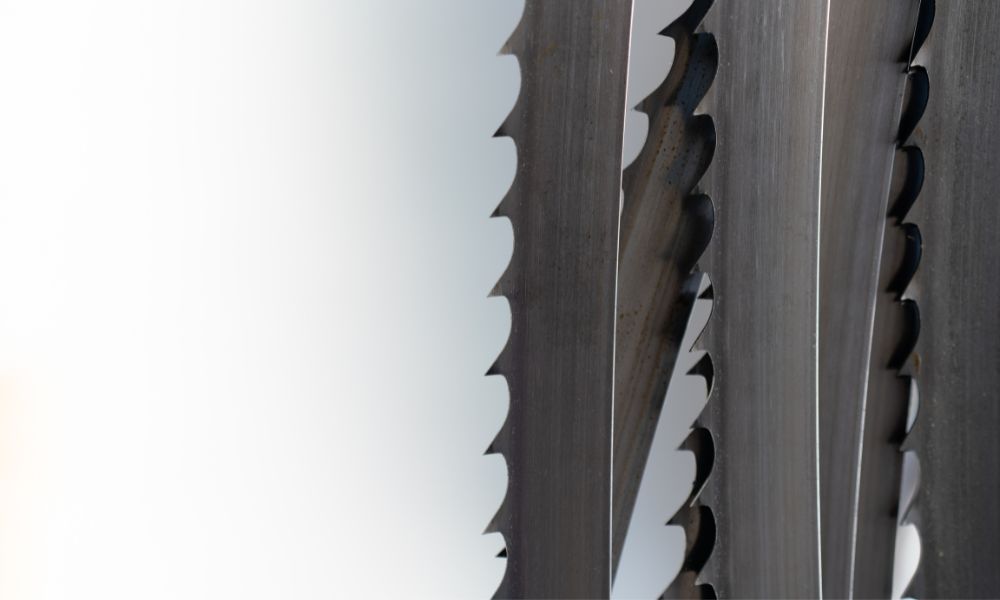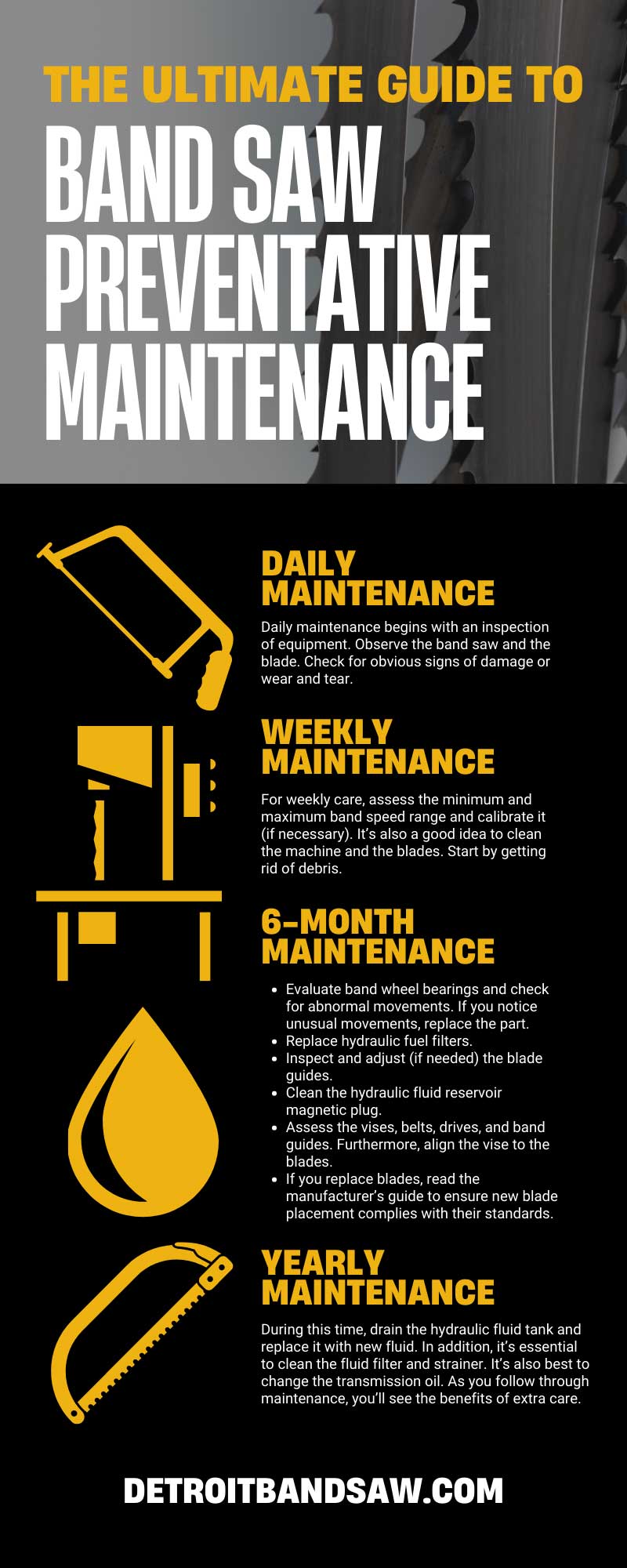One of the most valuable components of metalworking is preventative maintenance for band saws and blades. Prolong your equipment’s lifespan and avoid premature replacements by caring for the unit. Check out the ultimate guide to band saw preventive maintenance for more information.
Why You Should Perform Maintenance
Like any piece of equipment, maintenance ensures optimal performance and a prolonged lifespan—and saws are no exception to this factor. They’re an essential element to metal fabrication shops or metalworking hobbyists. Don’t let the machine or blades suffer unnecessary wear and tear when you can protect the equipment. And the best way to care for band saws is to understand preventative maintenance.
Essentially, preventative maintenance prevents unexpected equipment breakdowns. By caring for band saws with routine check-ups, you prolong their lifespan and ensure quality work. After all, a faulty band saw and blade won’t perform well. Stay on the safe side with routine maintenance.
Breaking Down Responsibilities
To keep everything in top condition, it’s best to break down responsibilities. Divide duties into daily, weekly, 6-month, and yearly maintenance. You want to provide the best care, and neglecting or overdoing check-ups can hinder the band saw. As you read the duties, you’ll notice that each sector requires different care. Pay attention to the expected tasks.
Create a checklist to help you understand duties and ensure that you complete everything in a timely manner.
Daily Maintenance
Daily maintenance begins with an inspection of equipment. Observe the band saw and the blade. Check for obvious signs of damage or wear and tear. For example, dents and scratches are noticeable. Afterward, evaluate the sawing fluid and lubricant levels. Here are some other things to do:
- Clean the blade’s teeth. Remove chips or leftover material debris.
- Check the blade’s tension. If it’s too low, it may crack. If it’s too high, it may cause wear and tear to wheel bearings.
- Apply cutting fluids. It prevents the blades from becoming too hot while cutting material.
- Evaluate the blade’s guides. Worn-out blade guides contribute to broken band saw blades. Maintain space between the guides to prevent the edges from moving out of place.
- Assess the alignment. Check the band wheel alignment daily to ensure that it’s not out of alignment. Failure to do so may result in premature wear and tear.
- Inspect the hydraulic system.
Weekly Maintenance
Along with daily maintenance, it’s essential to perform weekly check-ups. Select a day to undergo the necessary evaluations. For weekly care, assess the minimum and maximum band speed range and calibrate it (if necessary). It’s also a good idea to clean the machine and the blades. Start by getting rid of debris. Use a clean cloth to remove dust. Additionally, replace worn-out parts and replace belts with cracks.
In contrast to daily care, weekly maintenance is less “intense.” However, upholding band saws and blades requires special attention. Like metalworking projects, you notice inaccurate cuts and machine fatigue. Ultimately, just keep a watchful eye on the entire unit.
6-Month Maintenance
Bi-annual maintenance enhances your blade’s performance and lifespan. Consider 6-month care as a tune-up! Here are the essential things to do:
- Evaluate band wheel bearings and check for abnormal movements. If you notice unusual movements, replace the part.
- Replace hydraulic fuel filters.
- Inspect and adjust (if needed) the blade guides.
- Clean the hydraulic fluid reservoir magnetic plug.
- Assess the vises, belts, drives, and band guides. Furthermore, align the vise to the blades.
- If you replace blades, read the manufacturer’s guide to ensure new blade placement complies with their standards.
Yearly Maintenance
Similar to 6-month care, you can consider yearly maintenance as a tune-up. However, this is the time for internal work. During this time, drain the hydraulic fluid tank and replace it with new fluid. In addition, it’s essential to clean the fluid filter and strainer. It’s also best to change the transmission oil. As you follow through maintenance, you’ll see the benefits of extra care.
Prevent Problems and Prolong Lifespans
With proper care, you prevent problems. After all, no one wants a band saw that malfunctions or a blade that produces bad cuts. Taking care of equipment and following the recommended care checklist is great for prolonging the unit’s lifespan. To remember duties, create four checklists. Be sure to write down the maintenance dates and note any issues. For instance, if you replace a blade during a weekly check-up, write down “blade replacement on [insert date].” Doing so allows you to monitor the new part and keep up with the machine’s status.
Additional Tips and Smart Practices
Check out these additional tips and smart practices regarding specific parts of band saw maintenance.
- Use a tension gauge to evaluate the accuracy of the blade tension. Generally spacing for the back edge of the blade and the wheel flange is .032 inches, but you should consult you owner’s manual, as it varies between makes and models.
- Don’t use chipped or cracked blade guides. You risk damaging your material and band saw.
- While checking fluid, make sure the liquid flows freely through all fluid nozzles. If not, there may be a blockage or clog.
- Check for wear and tear on stationary and moveable vises.
- Assess band speed with a tachometer. Your readings should match the gauge.
- Replace any defective seals.
- Always read the manufacturer’s manual to ensure that band saw fluid levels are in place. For example, proper hydraulic fluid levels and transmission oil must be set at a specific level.
Don’t Forget About Safety
Although preventative maintenance focuses on good practices for machines, it’s still essential to address safety concerns. If you recognize severe damage, don’t operate the band saw because you risk injuring yourself. Furthermore, if the equipment makes unusual noises or displays dangerous signs (like smoking), unplug the band saw. Don’t service the machine while it’s in crisis. Wear the proper safety gear while utilizing the band saw and tie any loose hair back. Keeping yourself safe while checking and using the machine is critical.
After reading the ultimate guide to band saw preventive maintenance, you can effectively care for the equipment. If you need a refresher, always refer to this guide for help. Remember, preventative maintenance prevents unexpected breakdowns and unnecessary damage. By following daily, weekly, bi-annually, and annual care, you extend the lifespan of your band saw!
You can’t perform preventative maintenance without a band saw or blade. If you’re interested in premier metal band saws, please consider Detroit Band Saw Works. We only supply top-quality gear, and we’ll fit all your band saw needs. We’re the best for a reason, so browse our website today!

